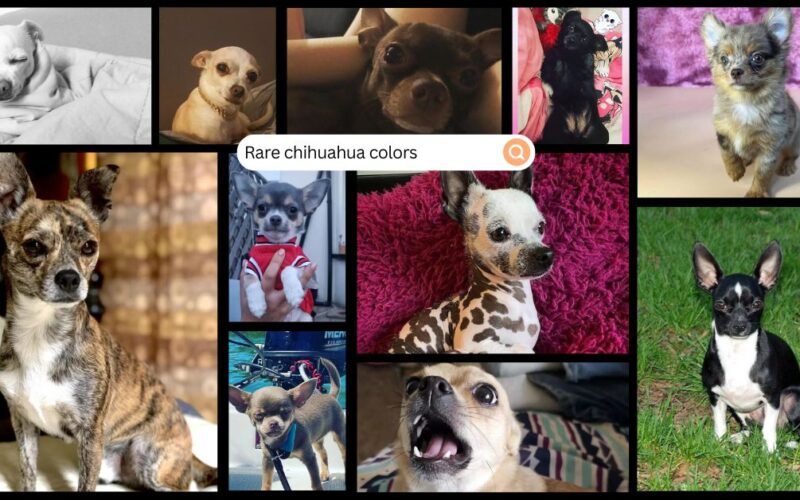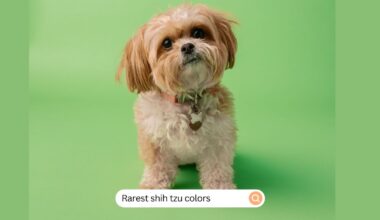About the Author: Jean Colt, a valued writer at MyPetDoggie and a dedicated student of English Literature at Yale University. Jean’s love for dogs, coupled with her literary skills, allows her to create engaging content that resonates with our pet-loving community. Her work reflects her passion for dogs and commitment to enhancing pet care knowledge.
Chihuahuas are cute, little but one of the most diverse dog breeds. They are known for their diminutive size, typically between 3 to 6 pounds. They look wonderful with their wide spectrum of coat colors.
They show wide genetic diversity with some common colors like fawn, black, or white, but, at the same time, they are well known due to some of their rare color patterns.
Some dog lovers think that chihuahuas originated from Mexico. It may be true but as per my research, they are now found everywhere around the world due to their creative breeding.
Keeping dogs as a pet is also a fashion symbol so chihuahuas, for their small size, are a trendy breed.
In this exploration of rare chihuahua colors, I will delve into the fascinating color variations. From ethereal lilacs to intricate brindle patterns, you will find every minute detail about this cute little breed.
8 Rare Chihuahua Colors
- White
- Merle
- Blue
- Lilac
- Gold
- Brindle
- Sable
- Panda
White
Pure white chihuahuas are the rarest of all breeds. They look so fine and smooth that they are considered undoubtedly the cutest breed, in my opinion at least.
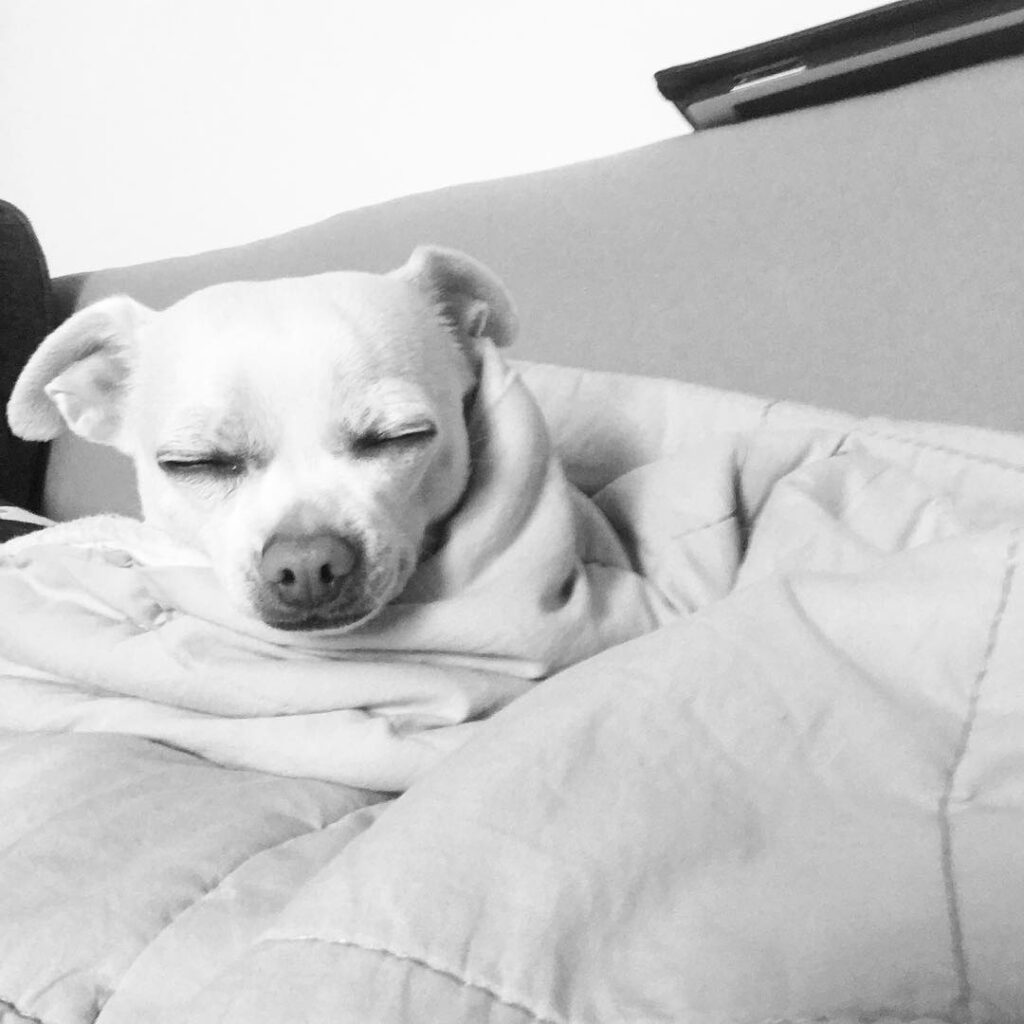
The white chihuahua lacks, to some extent, the substance that causes pigmentation but the slight quantity of pigmentation gives them black eyes, noses, and paws.
When you take your pet out in the park or somewhere else, you need to clean its fur or may need to wash it because of its white color.
It is a misconception among people that the white color causes a change in the temperament of chihuahuas. They are friendly and can be the best lap dogs. With proper and careful socialization, they can be your best furry friends.
Merle
The term “merle” refers to a coat pattern featuring irregular patches of darker colors, often set against a lighter background. Chihuahuas can have various base colors like blue, black, chocolate, and fawn.
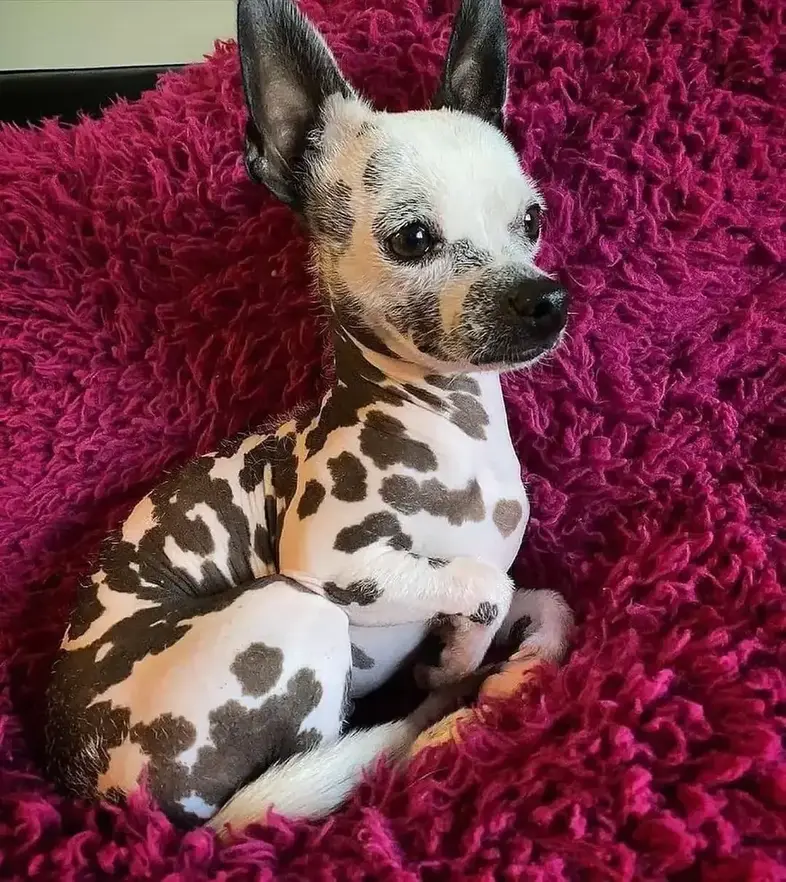
Merle chihuahuas are often seen with blue or partially blue-colored eyes but they are associated with a misconception regarding some health issues like deafness or blindness. The problem occurs only when two dogs with this merle gene are bred together.
The journey to produce Merle Chihuahuas involves the interplay of specific genes. Due to their rarity and difficult breeding process, merle chihuahuas hold a special place among rare chihuahuas colors.
Merle chihuahuas are common in breeds like Australian Shepherd, Beauceron, and Great Dane. Whether encountered in the park or admired from afar, Merle Chihuahuas leave an indelible mark, showcasing the beauty and diversity that make the world of dogs endlessly fascinating.
Blue
Blue chihuahuas, as you may have guessed, are not blue; rather they are characterized by a diluted black pigment that results in a unique bluish-gray hue.
The coat color ranging from a silvery blue to steel gray, gives a shimmering look and enhances their visual appeal.

They weigh between 2 to 6 pounds and are about 6 to 9 inches tall with erect ears. Blue chihuahuas are known for their loyalty and affection to their owners.
Their keen sense of awareness and alertness make them good watchdogs. It’s important to remember that individual behaviors can vary within the breed.
Blue chihuahuas exhibit high energy levels despite their small size. They are wary of strangers but proper training can make them friendly and well-mannered.
Lilac
The term “lilac” refers to a diluted chocolate color, resulting in a pale grayish-brown or lavender-like hue that sets them apart from their more common counterparts. This delicate color is achieved through specific genetic factors.
The prominent and bulging eyes of blue chihuahuas exhibit curiosity. They are intelligent and quick learners. They are keen observers also.
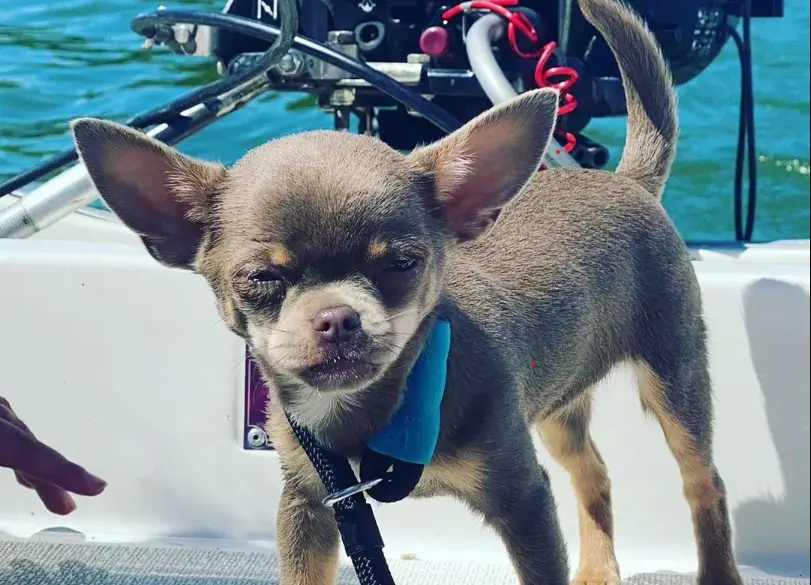
Lilac chihuahuas have a human-friendly nature and enjoy being lap dogs.
They may become anxious if left alone for extended periods, making them well-suited to households where someone is present most of the time.
Gold
This rare breed is the result of a golden retriever mixed with a chihuahua. The bright shining golden coat color makes them look charming.
Like all other chihuahuas, they are a small breed with good adaptability to adjust to different living conditions.

They are friendly-natured, responsive, and alert beings.
While Golden Chihuahuas share certain characteristics due to their breed and coat color, each dog’s unique personality is influenced by factors such as genetics, upbringing, and environment.
Brindle
Brindle chihuahua is a rare chihuahua color that looks different and unique from other chihuahuas. The brindle pattern consists of darker stripes or streaks that appear on the Chihuahua’s base coat color.
The base color can be any of the common Chihuahua coat colors, such as fawn, black, chocolate, or blue.
They can have short hair around the head and ears and somewhat long fluffy hairs on the tail and body.
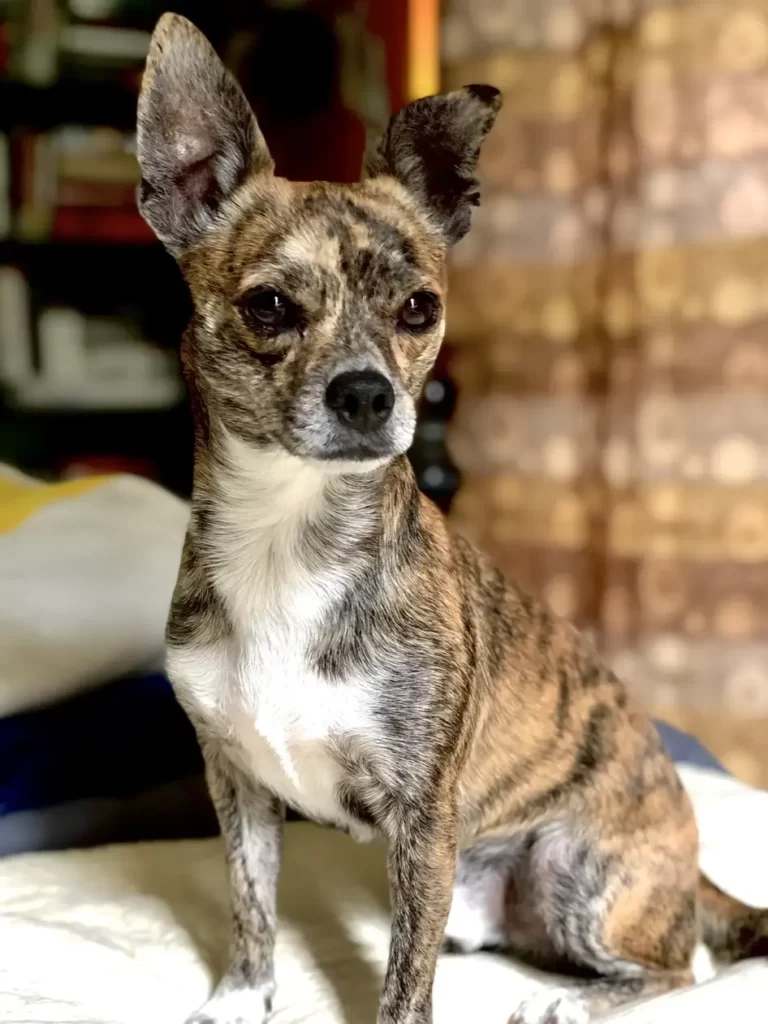
This breed is rare because they require both parents to carry the recessive brindle gene, if one of the parents is solid-colored, chances are most that the pup will be solid-colored. For this reason, they are difficult to breed and hence rare to find.
Some people believe that brindle chihuahuas are the result of the breeding of chihuahuas with terriers or dachshunds as they have strong hunting skills.
They mostly are 18 to 24 inches tall and weigh around 35 to 50 pounds. Their average age can be recorded as 12 to 15 years, as per my research.
Sable
The sable pattern has the tips black colored while the rest of the coat is silver or fawn. They are known as MAGIC COLOR CHANGE PUPPY as they mostly change colors from childhood to adulthood.
A sable coloring can be black, chocolate, or blue. The base color is mostly left when a sable chihuahua is an adult. I feel sable is a unique and intricate color among all rare chihuahua colors.

There are three varieties of sable chihuahuas enlisted in AKC; black sabled fawn, black sabled silver, and chocolate sabled fawn. Just one allele of sable will be enough for a puppy to develop this pattern because sable is a dominant gene.
We find black coloration throughout the coat in a clear sable pattern while tipped sable patterns exhibit the color on the head, back, and tail.
Panda
Yes, they are dogs, not pandas actually despite their panda look.
Panda chihuahua originated in China. Chow chow was the dog breed and after a two-hour session of grooming, chow chow is dyed like a panda.
They mostly live in the temperate forests of China. Due to their artificial and uncommon breeding, they are considered as one of the rare chihuahua colors.

The panda coat pattern is characterized by a predominantly white base coat with distinctive black patches around the eyes, ears, and sometimes the body. This striking contrast closely resembles the iconic markings of a panda bear.
You might be interested in: Explore the world of rarest Shih Tzu colors and their uniqueness.
6 Common Chihuahua Colors
- Chocolate
- Black
- Fawn
- Red
- Cream
- Brown
Chocolate
Chocolate is a common color among chihuahuas but when they are bred with another color such as tan, they may be rare.
Chocolate color washes out the black pigmentation. The Chihuahuas with darker coats than brown or liver are truly considered chocolate chihuahuas, however, some white splashes can also be acceptable.

This unique color adds a touch of warmth and charm to their appearance, setting them apart from other Chihuahua color variations.
Chocolate-colored chihuahuas have the same color skin, paw pads, and eye rims; as if they are made of chocolate. This color is a result of specific genetic factors that contribute to the pigmentation of their fur.
They are intelligent beings and can perceive threats easily. They are eager to learn when positive reinforcement techniques are employed.
Black
The black coat color genes are dominant. This is the reason that this color is common among chihuahuas. Chihuahuas can be different colors but I think black chihuahua is the cutest breed among them.
It is also notable that the black color usually fades as the puppy transforms into an adult.

There are some misconceptions regarding the temperament of black chihuahuas. People say that this is an aggressive dog breed but there are no scientific proofs of this claim.
Black chihuahuas commonly have some health issues but they require love and affection equally as other breeds.
Fawn
When I think of chihuahua, a fawn-colored puppy image comes to my mind. Probably because this is the most common breed. This color has dominated the breed for some time.
The AKC breed standard has specified the chihuahuas as APPLE DOME due to their head shape. But the fawns resemble V-shaped with their long ears.
Fawn, like black color, are relatively rare in the solid shade rather they are found mixed with other colors. They have several color combinations like sable chihuahua or fawn black.

Fawn chihuahua has a long nose, wide eyes, flattened skull, and V-shaped face – features commonly associated with the deer head Chihuahua.
Fawn chihuahuas can grow into a darker color. Fawn chihuahuas are bigger dogs with smaller bodies as they are light in weight.
Red
Red Chihuahuas, with their vibrant and captivating coat color, symbolizes a burst of passion and energy within the Chihuahua breed. This unique hue radiates warmth and vitality, making them stand out in the canine world.
The Pheomelanin pigment causes a red color coat depending on the genetic interaction of the parents. Some chihuahuas are bright red while some are reddish brown coats.

As this is a very popular breed among pets, they are found easily. The red pigment is only on the coat and not on the skin therefore most red chihuahuas have black noses, paws, and eye rims.
Cream
Cream chihuahuas are a common type of coat among this breed. They can mostly appear white but can have redness in their coat as they are artificially bred.
Chihuahuas generally change colors as they get mature so if you have bought a cream puppy, it may develop a beige tinge color. That is why most cream chihuahuas have black noses and eye rims.

Cream color chihuahuas exhibit a really elegant color and are good for those who need an eye-catching prominent pet.
Many cream chihuahuas have pale yellow skin. They are not very expensive compared to the other breeds.
Brown
Brown chihuahuas are one of the common colors among them. Its coat shades vary from light brown to dark brown giving it a profounding look. They even have eyes and a nose of the same color.
A solid brown chihuahua will be produced when both parents carry the recessive version of the brown color gene. This little breed is around 5 to 8 inches in height and 3 to 6.5 kg in weight.
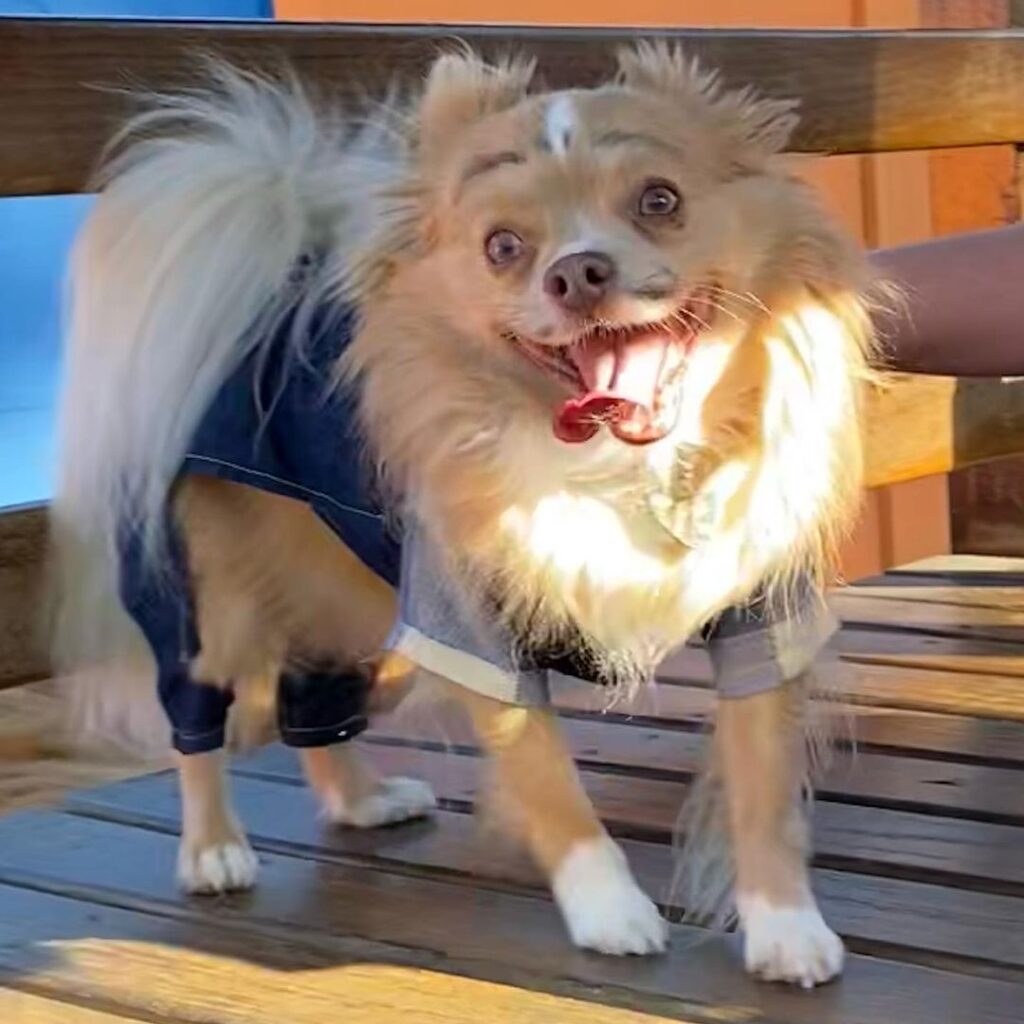
Brown chihuahuas are a loving family companion. Even they get separation anxiety if they get apart from the family gathering.
They are healthy dogs that can live a lifespan of 14 to 16 years with fewer visits to vets. You can get a brown chihuahua in the price range of $400 to $1500. Adoption costs far less than this.
You might be interested in: Find out about the smartest dog breeds and their unique intelligence.
7 Rarest Bi Colors Chihuahua
These are some of the rarest color combinations of chihuahuas.
- Blue and Tan
- Lilac and Tan
- Chocolate and Tan
- Red and White
- Blue and white
- Chocolate and White
- Black and White
Blue and Tan
Chihuahuas are interbred to produce a wide variety of breeds. It depends on the parents’ genes which color the offspring. Blue chihuahuas are popular among the breed, which are combined with other colors such as white markings or tan color.
A blue-tan chihuahua looks amazing with blue eyes and tan strands of pigmentation on the fur. This combination requires a dilution gene that fades the black pigmentation and turns it into blue.

Blue Chihuahuas have tan markings, typically on the eyebrows, cheeks, chest, and legs. The combination of blue and tan creates a dynamic and engaging look.
Lilac and Tan
Lilac and Tan Chihuahuas exhibit a truly unique and sophisticated coat color combination that sets them apart in the world of Chihuahua variations.
The interaction between these two colors results in a distinct appearance that reflects both charm and grace.
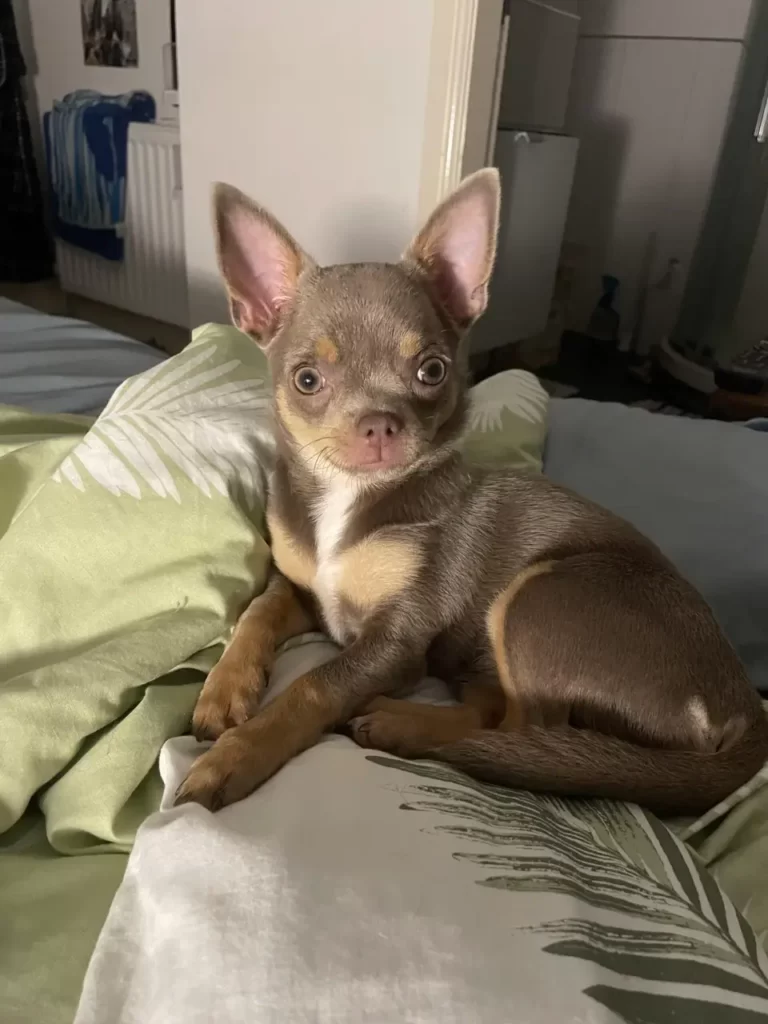
The lilac coat color is a soft and diluted shade of chocolate. It appears as a pale grayish-brown or even a lavender-tinted hue, making Lilac Chihuahuas stand out from their more common counterparts.
Tan markings typically appear on the eyebrows, cheeks, chest, legs, and sometimes around the muzzle. These tan accents provide a warm and harmonious contrast against the lilac background.
Chocolate and Tan
The combination of chocolate and tan not only creates a striking appearance but also offers a glimpse into the breed’s diversity. It showcases the balance between the richness of the chocolate and the gentle warmth of the tan.
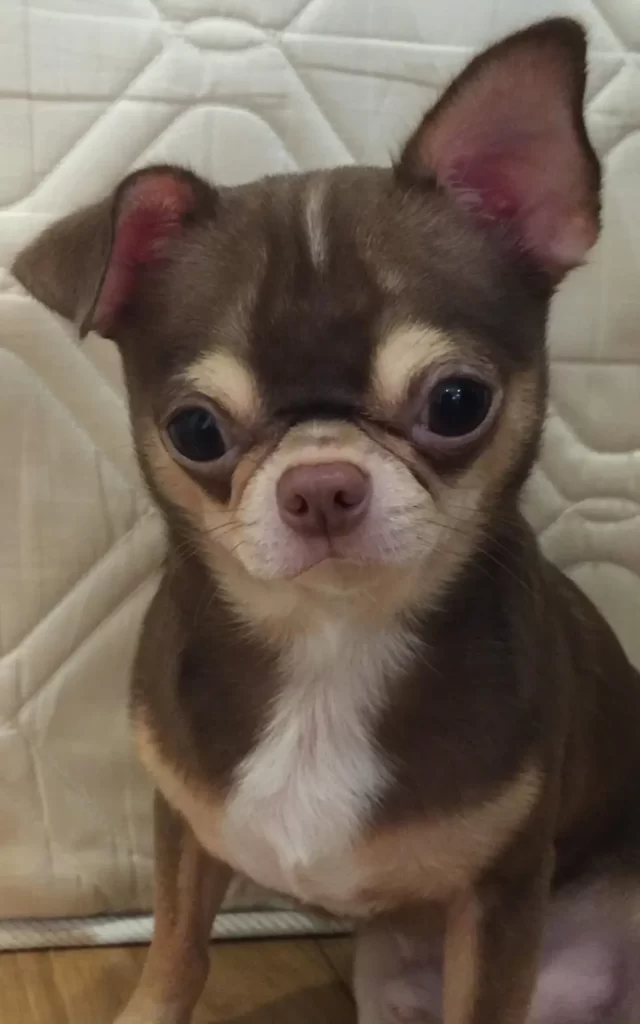
This color can range from deep cocoa shades to velvety browns, creating a visually pleasing sight. This pairing of colors creates a tapestry of beauty that admirably reflects the breed’s charm and unique character.
Red and White
The playful blend of red and white colors adds to their unique charm, making them stand out among other Chihuahua color variations.
The main color of a Red and White Chihuahua is red, which can range from a warm, deep shade to a lighter and brighter tone.
White markings appear on certain parts of the Chihuahua’s body, such as the chest, paws, and sometimes the face. These white areas provide a striking contrast against the red coat.
Blue and white
The blue coat is created by dilution of alleles and these chihuahuas have a little white splash on the chest.
As blue color is a rare color among chihuahuas these are high in price as compared to other breeds.
The primary color of a Blue and White Chihuahua is blue, which can vary from a soft grayish-blue to a deeper steel-blue shade.
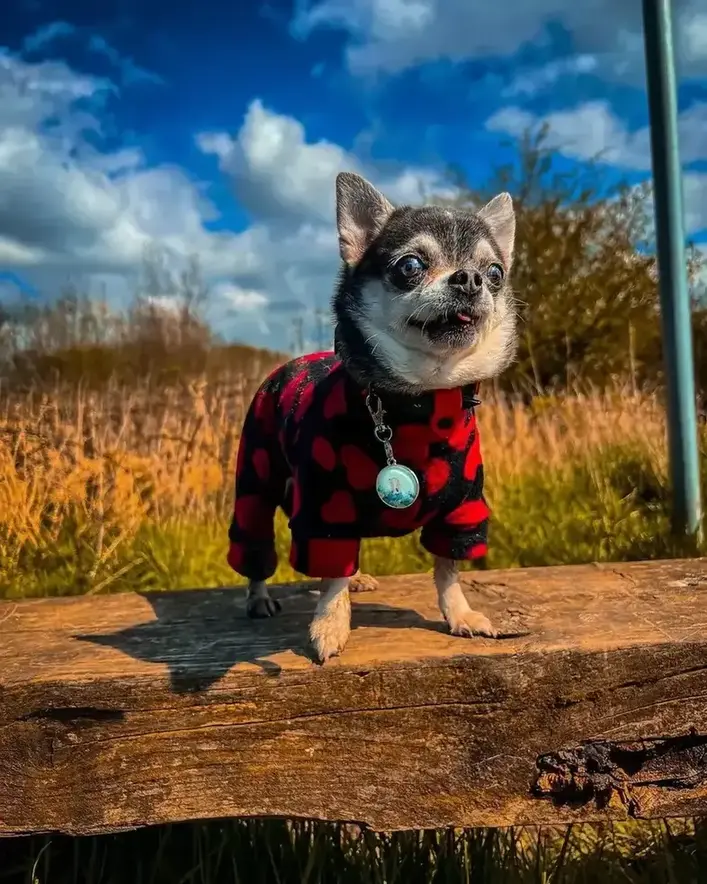
White markings on specific areas of the Chihuahua’s body, such as the chest, paws, and sometimes the face provide a sharp and appealing contrast against the blue coat.
Chocolate and White
This adorable combination looks like the pup is created from milk and chocolate. The chocolate hue is created by mutation of black color genes while the white patches show the absence of pigmentation.
The primary color of a Chocolate and White Chihuahua is chocolate, ranging from deep cocoa shades to velvety browns that resemble the color of chocolate.
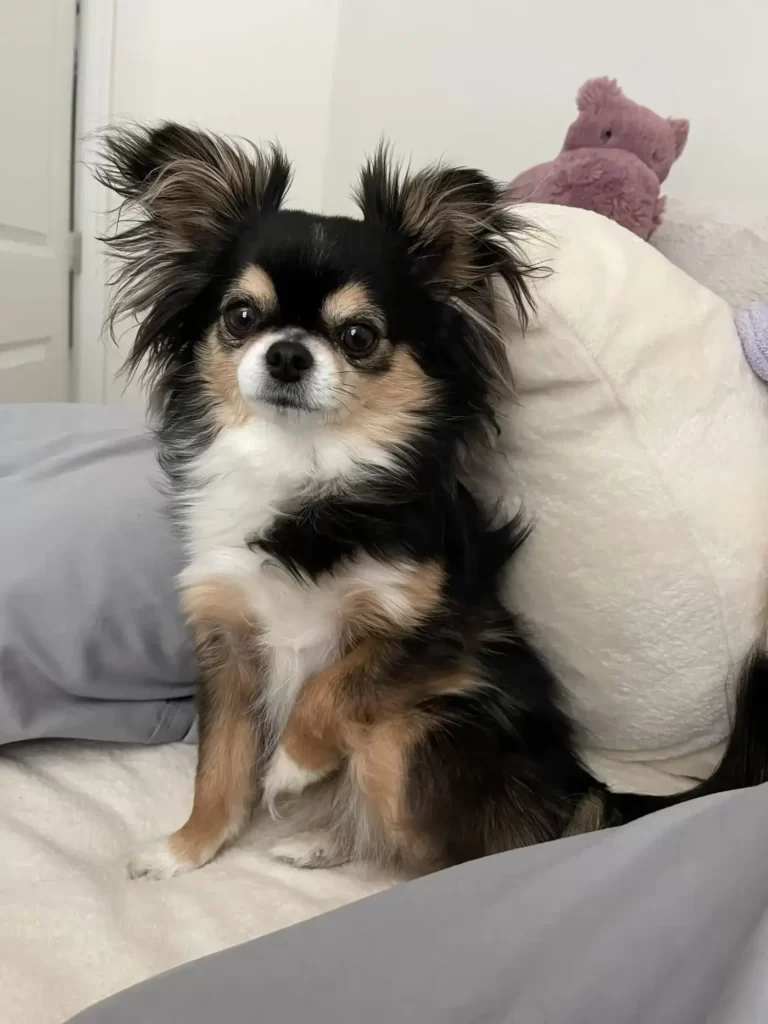
White markings grace specific areas of the Chihuahua’s body, such as the chest, paws, and occasionally the face. These white accents provide a bright and eye-catching contrast against the chocolate coat.
Black and White
This combination of contrasting colors is common in almost every dog breed. These chihuahuas stand out in their distinctive and eye-catching look.
The contrast between the black and white creates a visually captivating effect that draws attention.
The deep black tones, coupled with the crisp white markings, contribute to a bold and balanced appearance.
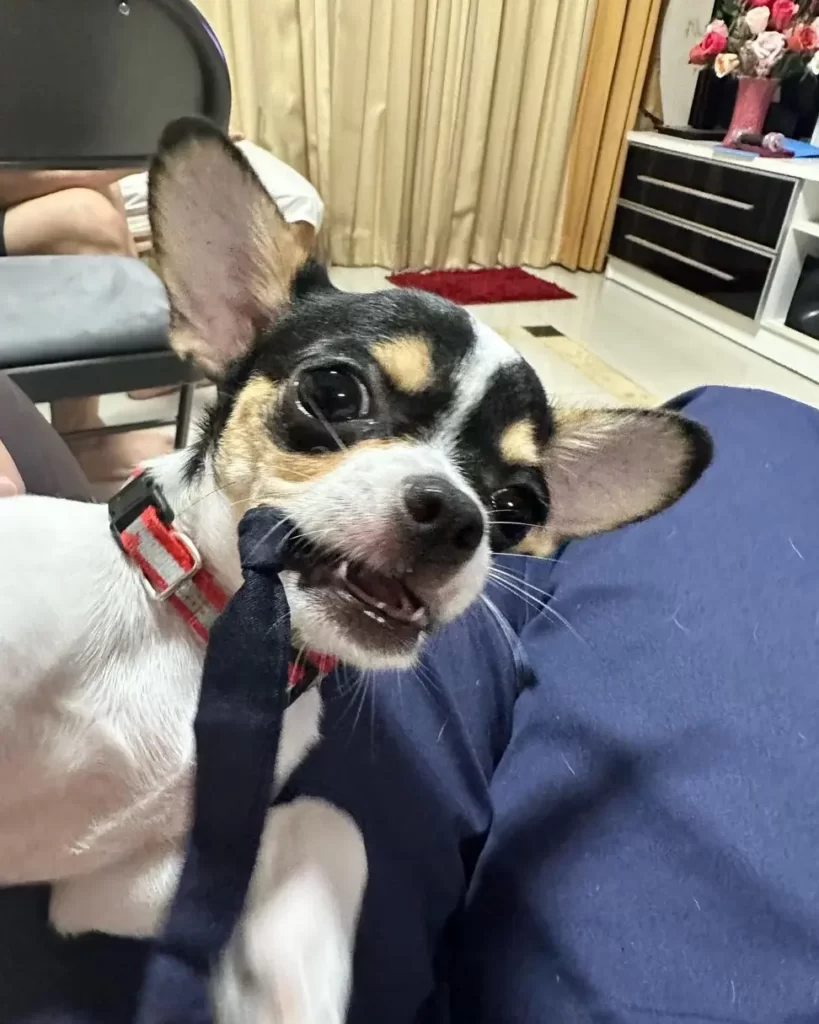
Black and White Chihuahuas boast a timeless color combination that appeals to those who value their classic and elegant look.
5 Best Patterns of Chihuahuas
Chihuahuas are known for their diverse and captivating coat patterns that add to their unique charm and individuality. From classic to intricate, these patterns enhance the breed’s overall allure. Here are some of the best-loved patterns.
- Solid color
- Sable
- Brindle
- Merle
- Panda
Solid color
A single, consistent color without any distinct patterns. The simplicity of a solid coat emphasizes the purity and elegance of the Chihuahua’s color. It seems to be a true breed and not an artificial breed but it is not always like that.
Sable
In the sable pattern, a few hairs are black tips and the rest of the body is fawn or silver. Sable is a very dominant gene so only one allele from either parent can make a sable chihuahua.
Three different varieties of sable patterning are common; clear, tipped, and shaded.
Black coloration will be observed on the coat in the chihuahua with a clear pattern.
Tipped patterns include the head, back, and tail while shaded sables will have more brown or black hairs on the back, neck, and rest of the body.
Brindle
It is a striking pattern of dark stripes on a lighter background. The bold contrast of colors in brindle coats creates a visually captivating look.
The AKC has distinct registration codes for three different types of brindle – blue brindle fawn, chocolate brindle fawn, and fawn brindled black, which some may refer to as reverse brindle.
As this pattern chihuahuas are rare, so are expensive as much as $3000 or more. But it would be a total waste of money because the tiger patterns that are admired will not last long as chihuahuas fade as they get older.
Merle
There are Irregular patches of darker color on a lighter base. The merle pattern adds a touch of whimsy and uniqueness to the Chihuahua’s appearance.
Merle coloring is not found naturally in chihuahua DNA, that is why they are artificially bred always. Therefore kennel clubs like UKC and Club of America oppose this pattern to be included for registration in AKC.
Another problem with this pattern is possible health issues like deafness or blindness in chihuahuas with the whitening of pigments.
Panda
This distinctive pattern is characterized by large black patches of color over a predominantly white coat. The name “panda” is derived from the resemblance to the black and white coloration of a panda bear.
The black patches often cover the ears and eyes, and sometimes extend over parts of the body, resembling the markings of a panda’s face.
This pattern adds to the breed’s diversity and showcases the wide range of coat variations that Chihuahuas can possess.
What causes these rare variations of color?
The rare variations of color in Chihuahuas, including patterns like merle, and brindle, and unique coat colors like lilac and blue, are primarily the result of genetic factors and variations in the expression of certain genes.
These genes play a crucial role in determining the pigmentation and patterns of a dog’s coat. These are some of the reasons why these variations occur:
- Genetic mutations
- Pigment productions
- Dilution genes
- Patterned genes
- Inherited traits
Why are some coat colors rarer than others?
The rarity of certain coat colors in Chihuahuas is a result of a complex interplay of genetics, breeding practices, historical factors, and the interactions of specific genes controlling pigmentation.
As breeding practices evolve and genetic diversity is maintained, some rare colors might become more prevalent over time, while others continue to remain cherished for their uniqueness.
Which Chihuahua Color is Right for You?
When considering which Chihuahua color is right for you, it’s important to think about your personal preferences, lifestyle, and the unique qualities each color variation brings to the table. Here are some points according to my knowledge ;
- Consider your lifestyle
- Personal aesthetics
- Compatibility
- Health and genetics
- Education and research
Common Question:
Are long-haired Chihuahua rare?
Long-haired chihuahuas are not as common as their short-haired counterparts are.
Is a pure black Chihuahua rare?
A pure black Chihuahua, while not the most common color variation, is not necessarily considered extremely rare within the Chihuahua breed.
Are Chihuahuas a lazy breed?
Chihuahuas are alert and active breeds. They are not lazy.
What is an apple head Chihuahua?
An Apple Head Chihuahua is a type of Chihuahua with a distinctive head shape that resembles the roundness of an apple.
Are Chihuahuas bigger than cats?
No, Chihuahuas are generally smaller than most cats in terms of size.
My final thoughts 👍
In the world of Chihuahuas, rare coat colors add a special charm. From merles to lilacs and unique patterns, these colors showcase the breed’s diversity. Each color tells a story of genetics and nature’s artistry. Blue, chocolate, sable—each hue adds to Chihuahuas’ uniqueness. These colors celebrate the bond between us and our beloved companions. They remind us of the variety of Chihuahua heritage. Every Chihuahua is a living example of the beauty nature creates. Rare coat colors aren’t just shades; they are part of the Chihuahua story.
